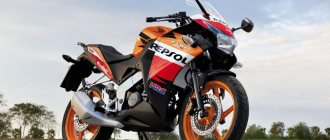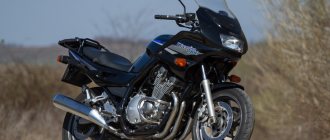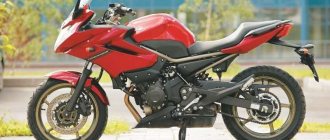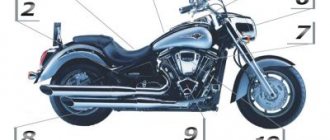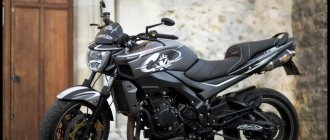| Yamaha TT250R (Open Enduro), 1993-2004 | Yamaha TT250R Raid, 1994-1996 | Yamaha TT-R250, 1999-2006 |
Soft enduro model Yamaha TT250R
appeared in 1993 in the Japanese domestic market and was often sold with the
Open Enduro
.
Since 1994, the model line has been replenished with a new modification, called the Yamaha TT250R Raid
. This modification positioned itself as a motorcycle for long trips, equipped with a classic round headlight, larger luggage mounts and a larger fuel tank (16 l instead of 9 l).
The regular enduro modification of the Yamaha TT250R began to be supplied to European countries in 1996 (first to the UK), from 1999 to Australia, and from 2003 to the USA. Also, 1996 was the last year of production of the touring version of the Raid.
In 2004, the Yamaha TT250R model finally left the market.
It is important to note that since 1999, an export modification of the Yamaha TT-R250
(not to be confused with the Yamaha TT250R discussed above). It was distinguished by the absence of mirrors, overall dimensions, tires, the presence of a simple tripmeter (instead of a full-fledged instrument panel), fuel tank (10 l instead of 9 l), chassis geometry, etc. This model was available in the markets of Europe and North America until 2006 inclusive .
Very often in reviews and reviews the TT250R and TT-R250 models are confused. Although similar in appearance and technically, they still have a fairly large number of differences, and therefore must be considered separately. The difficulty in identifying both models and the resulting confusion is most likely due to the fact that the Japanese version of the Yamaha TT250R (Open Enduro) was also available in foreign markets and in the same countries as the export Yamaha TT-R250.
Among the key features of the TT250R / TT-R250 series, it is worth noting a steel frame, a 1-cylinder 4-valve air-cooled engine, long-travel suspensions, wheels measuring 21′ and 18′, disc brakes, a 6-speed gearbox and from 113 kg of dry weight.
The main competitors of the Yamaha TT-R250R Raid in the class:
- Honda XR 250 Baja
- Suzuki Djebel 250
- Kawasaki KLR 250
The main competitors of the Yamaha TT-R250R / TT250R in the class:
- Kawasaki KLX 250
- Honda XR 250
- Suzuki DR 250
Brief history of the model
- 1993 - start of production and sales of the Yamaha TT250R model.
Model
: Yamaha TT250R (Japan).
Factory designation
: 4GY1.
- 1994 - appearance of the Yamaha TT250R Raid modification.
Model
: Yamaha TT250R Raid (Japan).
Factory designation
: 4GY3.
- 1995 - no significant changes.
Model
: Yamaha TT250R + Raid (Japan).
Factory designation
: 4RR1 + 4GY5.
- 1996 - The TT250R is officially available in the UK. Last year of production of the Raid modification.
Model
: Yamaha TT250R (UK);
Yamaha TT250R Raid (Japan). Factory designation
: 4MR2; 4WA1.
- 1997 is the final year of production of the TT250R for the Japanese market.
Model
: Yamaha TT250R (Japan).
Factory designation
: 4RR2.
- 1999 - Japanese TT250R only available in Australia. The appearance of the export modification TT-R250.
Model
: Yamaha TT250R (Australia);
Yamaha TT-R250 (Europe, North America). Factory designation
: 4PX5; 5GF1, 5GF2, 5GF3.
- 2000 - TT250R temporarily discontinued.
Model
: Yamaha TT-R250 (Europe, North America).
Factory designation
: 5GF4, 5GF5, 5GF6.
- 2001 - TT250R available in Europe.
Model
: Yamaha TT250R;
Yamaha TT-R250 (Europe, North America). Factory designation
: 4PX7; 5GF7, 5GF8, 5GF9.
- 2002 - no significant changes.
Model
: Yamaha TT250R;
Yamaha TT-R250 (Europe, North America). Factory designation
: 4PX8; 5GFA, 5GFB, 5GFC.
- 2003 - The TT250R is officially available in North America.
Model
: Yamaha TT250R;
Yamaha TT-R250 (Europe, North America). Factory designation
: 4PX9; 5GFD, 5GFF.
- 2004 is the last year of production of the TT250R.
Model
: Yamaha TT250R;
Yamaha TT-R250 (Europe, North America). Factory designation
: 4PXA; 5GFH, 5GFG, 5GFJ.
- 2005 - no significant changes.
Model
: Yamaha TT-R250 (North America).
Factory designation
: 5GFK, 5GFL.
- 2006 is the last year of production.
Model
: Yamaha TT-R250 (North America).
Factory designation
: 5GFN, 5GFP, 5GFR.
Flaws
The TTR 250 bike engine has one significant drawback - the cylinder liner is too thin. The wall thickness of the working part of the cylinder was reduced in order to increase the piston diameter and increase the volume of the combustion chamber. As a result, it turned out that the engine began to be afraid of cold water, or rather, its influence from the outside. You cannot ride a motorcycle into rivers or other bodies of water, as this will disrupt the thermal operating conditions of the engine. When trying to drive through a ford, the engine jams and the piston destroys the cylinder wall. In this situation, a major overhaul of the engine is guaranteed.
The disadvantages of the motorcycle also include the instability of the exhaust pipes to corrosion. The exhaust manifold is not chromed or coated with a protective anodizing layer. As a result, the metal rusts over time.
Both of these shortcomings were eliminated in due time. The exhaust pipes are coated with heat-resistant molybdenum, and the liner in the engine was eliminated; the cylinder began to be made of all-metal, followed by boring.
Specifications
Technical characteristics of Yamaha TT-R250 (TT250R, Raid):
| Model | Yamaha TT-R250 (TT250R, Raid) |
| Motorcycle type | enduro |
| Year of issue | 1993-2006 |
| Frame | steel |
| engine's type | 1-cylinder, 4-stroke |
| Working volume | 249 cm³ |
| Bore/Stroke | 73.0 x 59.6 mm |
| Compression ratio | 10.2:1 |
| Cooling | air |
| Number of valves per cylinder | DOHC, 4 valves |
| Fuel supply system | Carburetor, 1x Teikei Y30P |
| Ignition type | CDI |
| Maximum power | 30.0 hp (22.0 kW) at 8500 rpm |
| Maximum torque | 27.5 Nm (2.8 kg-m) at 7000 rpm |
| Clutch | Multi-disc in oil bath, cable drive |
| Transmission | 6-speed |
| type of drive | chain |
| Front tire size | 3.00-21 (51P) – TT250R / Raid 80/100-21 (51M) – TT-R250 |
| Rear tire size | 4.60-18 (63P) – TT250R / Raid 100/100-18 (59M) – TT-R250 |
| Front brakes | 1 disc, 245 mm, 2-piston caliper |
| Rear brakes | 1 disc, 220 mm, 1-piston caliper |
| Front suspension | 43 mm telescopic fork, 280 mm travel – TT250R, TT-R250 43 mm telescopic fork, 260 mm travel – TT250R Raid |
| Rear suspension | Pendulum with monoshock absorber (adjustable preload), stroke - 180 mm |
| Motorcycle length | 2145 mm – TT250R / Raid 2095 mm – TT-R250 |
| Motorcycle width | 835 mm – TT250R / TT-R250 850 mm – TT250R Raid |
| Motorcycle height | 1255 mm – TT250R 1290 mm – TT250R Raid 1260 mm – TT-R250 |
| Wheelbase | 1415 mm – TT250R 1425 mm – TT250R Raid 1405 mm – TT-R250 |
| Seat height | 895 mm – TT250R 875 mm – TT250R Raid 915 mm – TT-R250 |
| Minimum ground clearance (clearance) | 285 mm – TT250R 265 mm – TT250R Raid 305 mm – TT-R250 |
| Acceleration 0-100 km/h (0-60 mph) | |
| Maximum speed | 130 km/h |
| Gas tank capacity | 9.0 l – TT250R 10.0 l – TT-R250 16.0 l – TT250R Raid |
| Motorcycle weight (dry) | 113 kg – TT250R 121 kg – TT250R Raid |
| Motorcycle weight (curb) | 124 kg – TT-R250 |
Chassis and brakes
The frame of this product is made of steel. By type it is duplex. There is no chic in its appearance, but all elements are made carefully and tastefully. The steering wheel here is typical, as are the spoked wheels, which immediately makes it possible to recognize the TTR 250 as a purebred enduro.
The rear pendulum suspension here is equipped with a monoshock absorber, and the front one is a telescopic fork. The TTR 250 brakes at the rear using a 220 mm disc complete with a single-piston caliper, and at the front for this purpose a 245 mm disc is used together with a two-piston caliper.
Reviews
Reviews about Yamaha TT-R250:
Expand Collapse
Yamaha TT-R 250. Reliable, unpretentious. Low consumption 5 liters per 100. Large tank. You can cross fords along the road without any problems. Maximum speed 120 km/h. Excellent maneuverability, low weight. Wide comfortable seat, I took it specifically for trips together. My height is 195, weight 110, everything is very comfortable and it’s not a bummer with a passenger. I was looking specifically for one with a kick and electric starter, very good light - large headlight). We don't kill, hand protection. There is traction at the bottom, but worse than that of its classmate Honda XR 250. During the season I drove 5000 km along roads, swamps, forests and various fornications... pah-pah without problems. Changed pads and oil.
The first rides demonstrated the normal operation of the suspension, good rigidity of the frame, the whole body of the motorcycle resembled a sinewy fighter, not afraid even of the cross-country track. The brakes are sufficient and allow you to really regulate the engagement of the wheel with the road, which for a beginner who was initially testing Japanese motorcycle equipment left no doubt that the brakes could be worse. I was not pleased with the speed in straight-line movement on asphalt. The real cruising speed can be called a speed of 95 km per hour; at a higher speed, the engine began to demonstrate a higher speed, which raised some doubts about the engine’s performance for a long time in this mode without reducing its service life.
The Yamaha TT250R motorcycle pleased me with its torque, since the experience of riding motorcycles and two-stroke engines, even with larger volumes, involved spinning up the engine when starting to move from a standstill, on the Yamaha TT250R motorcycle this was not required, the engine thrust was reminiscent of the smoothly distributed power of a diesel car .
The front suspension has adjustments that I never had the opportunity to adjust. The lighting technology is sufficient, which cannot be said about the main headlight. This shortcoming is written about in all articles. The instrument panel is pleasant to read, the electronic speedometer has a nice, noble green backlight, and the numbers on the display are large. The steering wheel controls are comfortable, the light control knobs are comfortable and their appearance inspires respect.
YAMAHA TTR 250 OPEN ENDURO. I bought it for 100,000 rubles. I skated 2 seasons. Mileage... Mileage is reset once if the battery is loosely connected. I bought it with a mileage of 22,500 km. The battery is suitable for a scooter.
The light is bad. You can install a lamp with increased light output in a car store, you can find it for 300 rubles
Tank 9 liters. 7 + 2 reserve Enough for about 140 km. It depends where and how to go. My SPEED on road wheels is 135-140 km. On off-road tires 125-130 km per hour. Comfortable speed on the highway is 100-110 km per hour.
It is better to put a tuned steering wheel. The original one is flimsy and low, bends when dropped. The original mugs protect the clutch and brake handles more or less tolerably. If the saddle breaks, it is simply covered with leatherette.
Stickers will give +10 skill to the rider's coolness and protect against scratches on the plastic 
For whom
Here are the main features of the Yamaha TTR 250:
- maintainability;
- reliability;
- affordable price.
In addition, the motorcycle is sufficiently developed, and there will not be any glaring problems with it. Convenient and simple, the Yamaha TTR 250 will suit many connoisseurs of the class who need a good and inexpensive option with decent performance.
Motorcycle Yamaha TT 250R Raid 1996 review
The description of the Yamaha TT 250R Raid 1996 motorcycle is in the queue for publication of the article. Announcement: Today, for almost every new motorcycle that comes into being, marketers strive to carve out their own niche. This one is a road sport, this one is a recreational enduro. But what class should we include a motorcycle that has a little bit of everything? A good bike should have a reliable engine, comfortable ergonomics and simple controls...
Yamaha TT 250R Raid is a motorcycle of average popularity in Russia equipped with an average power 30 hp engine. Despite the fact that good models of motorcycles have a very respectable price, and the season for their use is relatively short, the motorcycle market is developing rapidly. And if you believe the words of dealers, then some models of recently released motorcycles are selling like hot cakes at the beginning of the season, and the models brought to Russia are clearly not enough to fully satisfy consumer demand.
A motorcycle has long ceased to be an alternative to a car, and the times when this equipment was bought only because there was not enough money for a full-fledged car are forgotten. Nowadays, two-wheelers can be called technological marvels in many cases, and their cost can be compared with that of prestigious cars.
Many people have started buying motorcycles for hobby purposes as riding or even collecting them has become a good pastime for many people. Many motorcycles, for example the Yamaha TT 250R Raid, whose technical characteristics allow the model to be called a prestigious brand, are in demand among both beginners and experienced motorcyclists.
Currently, it is impossible to purchase a new Yamaha TT 250R Raid motorcycle from the 1996 model year, since their production stopped 20 years ago. At the same time, the Yamaha TT 250R Raid has excellent technical characteristics, so many are eager to purchase, if not a new, then at least a used version.
Motorcycles with an engine capacity of 249 cc. see, appeared as a result of long work of inventors who sought to create a model that was not inferior in characteristics to other versions of the motorcycle. In some cases, these models are not only not inferior, but also ahead of other motorcycles, as they have minimal fuel consumption and other excellent parameters.
The Yamaha TT 250R Raid belongs to a common class of motorcycles with an engine capacity of 125 to 250 kb. cmAs a rule, these are light and relatively low-power motorcycles. Here you will get flexible control, easy steering and low weight of the motorcycle. Therefore, such motorcycles are suitable for almost every beginner, regardless of their characteristics. The exception is motorcycles with two-stroke engines of the “sport” and “cross” classes, since bikes of this class are distinguished by more power and an extremely sharp response to the throttle, which also does not make them obedient to control.
Go to the entire range of Yamaha motorcycles, on this page you can find Yamaha TT 250R Raid motorcycles from other years of production and information about them
May 6, 2008
In the wide range of compact Japanese SUVs, the Yamaha TT250R Raid has always occupied a special place. Funny appearance and decent characteristics, backed by colossal reliability, do not allow the model to “retire”. The device has been produced unchanged since 1994 and is very popular in its homeland. Long-travel suspensions, solid ground clearance, a large gas tank and a powerful “kangurin” around the headlight leave no doubt that you can go on a long hike with a small enduro even tomorrow. Or take a ride through the dacha wilds. The layout of the chassis and power unit is traditional for Yamaha SUVs: a frame open at the bottom encloses an air-oil-cooled engine, using it as a power element. It's nice that most TT250R Raids come from Japan with an optional oil cooler.
The motorcycle pleases with its rich equipment - it has an electric starter, a liquid crystal instrument panel, a powerful headlight and arches in the rear fender area, which can be used to secure luggage or as a basis for the trunk. The condition of used TTs arriving from Japan is always excellent - the device does not experience off-road conditions in its homeland; there are other models for this purpose. The specific Russian consumer mentality did not accept compact SUVs for a long time: they were considered weak and unsuitable for our conditions. And in vain - for $2500-3500, which is how much they usually ask for a “quarter” in the second-hand category, you can buy a very good device that will give you more than one season of trouble-free operation. Now, in light of the growing interest in everything universal and all-terrain, we will introduce you to different opinions about the Yamaha TT250R Raid. And you decide for yourself: is the car destined to become a Russian bestseller? Vladimir Avseenko, independent expert Height - 183 cm, driving experience - 26 years, rides a Yamaha YZ426, Honda XR650R
TT250R is an excellent vehicle for beginners, and its potential owner must have good physical characteristics.
For its modest size, this Yamaha is heavy. Of course, it can be made easier: you can remove a lot of attachments that are useless for off-road use, but hardly anyone will do this. Excess weight is a double-edged sword. On the one hand, thanks to him, the car confidently “stands” on the road, and on the other hand, it pays with a meager maximum speed. 110 km/h is all I could squeeze out of the TT. I repeat, for a novice motorcyclist the car will seem like the height of practicality and versatility. For those with minimal experience, the Yamaha seems dreary - the riding style on it is somewhat reminiscent of a moped. Nevertheless, the motorcycle has a lot of advantages: an informative liquid crystal instrument panel, a comfortable driving position, a clear gearbox and a high-torque engine. The TT steers, accelerates, and brakes simply superbly. It’s easy to “goat”... A motorcycle is capable of giving its owner the whole range of sensations that can be obtained from a small enduro. The machine is easy to operate, and a novice owner will quickly “grow out” of it. The device helps in training and very quickly gives confidence that the owner has become a good driver. Therefore, many people who are busy searching for “their” motorcycle tend to part with the TT after a season. The exceptions are those who consciously chose this model for measured use in the village or in the country. Those who are concerned about the problem of purchasing an unpretentious and reliable two-wheeled vehicle will not find a better Yamaha. Go fishing, go to the forest or go to the store... TTs, as a rule, come from Japan in excellent condition, and the cars that have traveled with us are still strong. And all for the same reason - even in the hands of a novice athlete this motorcycle will not last long. Among the shortcomings, I note that the motorcycle is equipped with a narrow chain - this does not even last a season off-road. There is simply no suspension - it is only suitable for more or less smooth roads. But the front fork, for all its external flimsiness, pleased with its rigidity - the stays are difficult to turn in the yokes. The Yamaha TT250R is an extremely self-sufficient model: it is good as is and does not require any improvements. If it stops satisfying you, then it’s time to change it. Alexey Karklinsky, Motor Review expert Height - 179 cm, driving experience - 22 years, drives a Honda VFR800
With the TT everything is very simple.
It just happened spontaneously that this motorcycle is one of the most imported light enduro motorcycles to Russia. And it also happened spontaneously in Japan that the TT250R Raid is one of the few SUVs that is not popular with endurists there. Almost 90% of these “Yamahas” come to us after asphalt use. There is also a minus to this: most of the vehicles come to us with considerable mileage. However, 50,000 km on the odometer is not a critical mark. Extreme qualities in the character of the engine or suspensions are difficult to find. At the same time, the engine is reliable and unpretentious. Those who are going to choose between “quarters” will be interested to know that the engine characteristics are almost identical to the engines of the Honda XR250, Honda AX1 and Suzuki Djebel 250. The suspensions, which have a minimum of adjustments, leave much to be desired. The car is unlikely to be suitable for rough off-road use. “Tetekha” is for residents of villages, dachas, and small towns, where high-torque and reliable motorcycles are in favor. The Yamaha will also work in a metropolis, but for many its “maximum speed” will seem insufficient. You shouldn't expect any surprises: everything that the device promises with its appearance is what it delivers. And no more. Attempts to “charge” the engine will lead to nothing. At best, you will get a rich sound from the muffler. Much more interesting is the “game” with the number of teeth on the sprockets. I know from personal experience that reducing the front by one tooth and increasing the rear by three leads to a noticeable increase in traction. Alas, further “knocking out teeth” is impossible - the chain is already beginning to slide along the substrate. There are cars equipped with a chain with a small pitch - the service life of such in off-road conditions is catastrophically short. The problem is “cured” by purchasing full-fledged sprockets and chain. The suspensions are reliable, but “adult” “tetekhs” had some problems with the rear shock absorber. However, the unit is collapsible, and therefore repairable. In addition, you can put any cartridges, guide bushings, seals from WP or Ohlins there. The front fork is very easy to move. By the way, during disassembly it is possible to adjust the stiffness; the fork is very sensitive to the viscosity of the liquid. From my own operating experience, I note that the TT250R Raid is tolerant of falls - only the rear plastic lining is scratched, in the worst case, the clutch and brake handles bend. Leonid Yushkin, Motor Review expert Height - 189 cm, driving experience - 20 years, drives a Suzuki DR-Z400
A good average - that's what I would call this Yamaha.
And all because I had to ride not only it, but also its closest “relatives” - Suzuki Djebel 250, Kawasaki KLX250 and Honda XR250. Each of them is distinguished by, say, a deviation into one or another off-road specificity, but the TT250R Raid is sort of average - a little bit of everything and from everyone. A true all-rounder. A large gas tank is a clear trump card over competitors and a good option for Russian operation. The powerful engine and short first gears are immediately impressive. Like most Yamahas, the TT has an unclear neutral engagement. Otherwise, there are no complaints about the checkpoint. The motorcycle performs well on the asphalt and in high-speed racing on the ground. It is really capable of driving in hard sports mode, but at the same time there are concerns about the chassis: after all, the energy consumption of the suspensions is not so great. If on an ordinary country road the shock absorbers cope with their duties, then on rough terrain the front “telescope” sometimes breaks through. But there is no need to demand hard enduro capabilities from the TT. This device is more likely for an active tourist who sometimes wants to go off the path into a forest windfall. Light weight and excellent low-end traction make the machine practically all-climbable. Getting stuck in a ford on a TT is not as tragic as getting a heavy Honda XR650R stuck there. Raid “forces” insurmountable obstacles in the hands of the owner. As a fan of enduro, I would like to recommend this device to those who need a “workhorse”. The TT is an excellent device for country use, but rural riders will generally find it the height of perfection. The Yamaha is also suitable for traveling around the city. Long-travel suspensions allow you not to notice potholes and curbs. True, on a country road, where you could accelerate, you don’t feel comfortable. The undoubted advantage of the model is ease of use. Consumables are always available in the salons. In addition, this “quarter” is “shod” with standard Enduror tires, the range of which is now colossal. What are the nuances? The model is equipped with a non-standard small battery. You can’t buy the battery in a store; you have to order it from Japan, and it’s not cheap – about $100. Andrey Trifonov, Motor Review columnist Height - 191 cm, driving experience - 8 years, drives a Suzuki GSF1200S Bandit
Many people know what a parquet jeep is.
So: Yamaha TT250R Raid - parquet enduro. It is equipped with all possible off-road “bells and whistles”, from long-travel suspensions to the “kanguratnik”. However, its off-road capabilities are quite modest. The first meeting was surprising. Despite all the cocky appearance of the TT, you feel very comfortable behind the wheel, not at all like other cars in this class. High, almost road-going handlebars, wide saddle, wide tank... There is something about the Yamaha TW125 in this. And the engine responds smoothly to gas, not as sharply as on most enduros. Acceleration is sedate, but confident. The engine performance is very smooth, without pronounced surges and dips. The thrust is juicy throughout the entire engine speed range. This is noticeable for this reason: the Yamaha gearbox does not work very clearly, and in order not to disturb it again, you will inevitably use all the capabilities of the engine. At high speed off-road you feel very uncomfortable. Still, soft suspension settings are, at best, suitable for a rural highway, but not for field terrain. To a greater extent, this remark applies to the front fork, which, although it is adjustable for preload, punches in any position, although without a pronounced impact. Things are better with the rear monoshock absorber - only when driving with a passenger I managed to “break through” it a couple of times. We were pleased with the rigidity of the frame and rear swingarm. Both on asphalt and on dirt, the motorcycle is very stable, turns decently, without breaking. Even at maximum speed, “shod” in grippy “rubber”, the device is stable on the road, and does not “float”, like many representatives of this tribe. Is the maximum speed not so high? But you don’t want to drive it faster - the wind starts blowing so hard that you will inevitably slow down. The disc brakes on both wheels are also excellent, as is the lighting technology. Probably, initially there is no need to judge this Yamaha strictly. There is no need to demand from it the capabilities of sports cars, and especially motocross cars. Versatility is the goal that Japanese designers have achieved. After all, not everyone wants to climb up to the tank in the mud or force up sheer cliffs. Many people (I don’t mean the athletes who make up the bulk of our endurists) enjoy an evening ride through the countryside, a trip to the river for barbecue or to the forest to pick mushrooms, regardless of the condition of the road or its absence. For such romantics, the TT250R Raid is unconditionally suitable. Ivan Borisenko, Motor Review expert Height - 179 cm, driving experience - 8 years, rides a Yamaha WR426
Fans of active mud mixing are quite lenient about this model.
Why? Only at speeds up to 60 km/h in the saddle of this bike you can taste all the delights of off-road riding. If you want it faster, the pendants will “sign” their own insolvency. Moreover, attempts to adjust or tune the shock absorbers will lead to nothing. Although I can perfectly understand the delight of a beginner who, after some pseudo-endurance Jawa, will ride the TT250R Raid. For all its off-road appearance and almost cross-country fit, the car impresses with its driving comfort. Personally, I like to slowly chug along the TT along forest paths, drive through puddles or perfect my wheelie. Moderately high-torque engine, good gear ratios... What else do you need from a “quarter”? If you don’t cross the line for which this bike is designed, you can get the best impressions from it. The motorcycle is also not bad in the city, especially in traffic jams - scooters are far from its all-access capabilities. But as soon as the cars on the road clear up, you feel discomfort from the reduced speed capabilities. “Maximum speed” is nothing - 125 km/h with a tailwind. I wouldn’t dare buy such a device for myself - I’m used to tough sports equipment. I don’t need a comfortable saddle and soft suspension, and I want a meaner motor. And if I choose from the “250” class, I would prefer the Honda XR250. And the TT is suitable for those who, in their middle years, decided to find out what kind of beasts these motorcycles are. Alexander Dmitriev, editor-in-chief of Motor Review Height - 183 cm, driving experience - 14 years, rides a Suzuki DR-Z400R, Yamaha FZR1000
Probably, it was harder for me than others: I choose a similar motorcycle for myself, and the TT250R is one of the main contenders. Lightweight, comfortable, like worn-in jeans, and unpretentious. With a full double saddle and the ability to install a strong luggage rack. Do you know what the power reserve of this motorcycle is on a 16-liter gas tank? 400 km on road, 300 – on light off-road. None of the competitors can boast of this! But too soft suspensions are frankly frustrating. I have never ridden a TT around the city - only along paths and gullies. And then I decided to try it. To be honest, I was slightly shocked. After powerful and heavy motorcycles, the TT seemed like fluff. But not one that is carried by the will of the wind, but absolutely controllable. Like alpine skiing. Or snowboarding - whatever you like. The wheels were “shod” with tires with a rare off-road tread, but despite this I did not experience any problems with their adhesion to the asphalt. Incredible turns between cars, when it seems you are about to hit something expensive, braking while lifting the front wheel... Downhill on Tverskaya I accelerated to 130 km/h according to the speedometer. So what if he flatters the driver and in fact it was no more than 115 km/h, the main thing is the sensations! And they are just super. It seems that you are flying and run into another traffic jam. But I experienced the most vivid emotions when riding in tandem with last year’s Fireblade. The powerful sportbike overtook me only on rare straight lines in the city, and even when driving “not according to the rules” - by driving into the oncoming lane (I don’t do that myself). We arrived at our destination at the same time! And who got more buzz is the question. The only thing that bothered me was that I was driving only with full throttle - how long would the engine last? The main thing is not to wish the impossible from the TT and use it for its intended purpose. Obviously, there are more powerful and tougher motorcycles for country crosses, enduro competitions and rally raids. Will I choose TT? I wish I could remember XR! And then I’ll decide. MotoReview 2002
About reliability
The Yamaha TT-R250R Open Enduro and Yamaha TT-R250R Raid models are quite reliable motorcycles, despite their age. Possible problems and “illnesses” include the following:
- Air cooling - for simple pleasure driving it is enough, for hard off-road driving it is advisable to install an improved oil cooler, otherwise there is a high risk of engine overheating with subsequent failure. Engine life: 50,000 - 70,000 km;
- During harsh off-road use, the clutch quickly fails;
- The stock exhaust is prone to corrosion;
- The suspensions are designed for light off-road driving and are not designed for jumps, from which they quickly fail.
